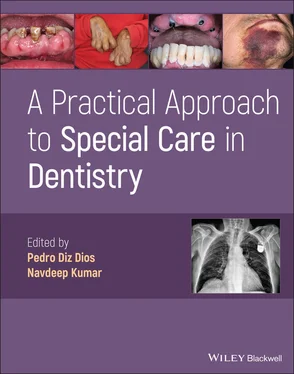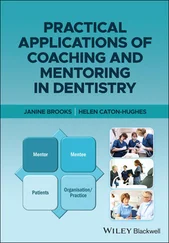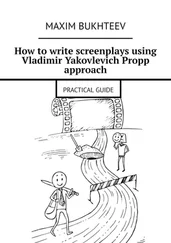A Practical Approach to Special Care in Dentistry
Здесь есть возможность читать онлайн «A Practical Approach to Special Care in Dentistry» — ознакомительный отрывок электронной книги совершенно бесплатно, а после прочтения отрывка купить полную версию. В некоторых случаях можно слушать аудио, скачать через торрент в формате fb2 и присутствует краткое содержание. Жанр: unrecognised, на английском языке. Описание произведения, (предисловие) а так же отзывы посетителей доступны на портале библиотеки ЛибКат.
- Название:A Practical Approach to Special Care in Dentistry
- Автор:
- Жанр:
- Год:неизвестен
- ISBN:нет данных
- Рейтинг книги:3 / 5. Голосов: 1
-
Избранное:Добавить в избранное
- Отзывы:
-
Ваша оценка:
- 60
- 1
- 2
- 3
- 4
- 5
A Practical Approach to Special Care in Dentistry: краткое содержание, описание и аннотация
Предлагаем к чтению аннотацию, описание, краткое содержание или предисловие (зависит от того, что написал сам автор книги «A Practical Approach to Special Care in Dentistry»). Если вы не нашли необходимую информацию о книге — напишите в комментариях, мы постараемся отыскать её.
Learn to treat dental patients with disabilities or who are medically compromised A Practical Approach to Special Care in Dentistry
A Practical Approach to Special Care in Dentistry
A Practical Approach to Special Care in Dentistry — читать онлайн ознакомительный отрывок
Ниже представлен текст книги, разбитый по страницам. Система сохранения места последней прочитанной страницы, позволяет с удобством читать онлайн бесплатно книгу «A Practical Approach to Special Care in Dentistry», без необходимости каждый раз заново искать на чём Вы остановились. Поставьте закладку, и сможете в любой момент перейти на страницу, на которой закончили чтение.
Интервал:
Закладка:
Duchenne muscular dystrophy is the most common amongst children and is characterised by:Inheritance (linked to the X chromosome)Onset in the first years of childhoodInvolvement of all muscles (generalised muscle weakness)Muscle pseudohypertrophy (enlargement)Pelvic girdle muscle impairmentDifficulty standing up (Gowers sign)Severe lumbar lordosis and peculiar gait (‘duck‐like’)Confined to wheelchair before pubertyCardiomyopathyRespiratory impairmentIn some cases, intellectual impairment may be presentDeath in the first years of the adult stage
Diagnosis
The initial diagnosis is based on clinical findings (e.g. generalised muscle weakness) Table 1.3.2 Classification and characteristics of muscular dystrophy.TypeSex Age at onsetMuscles involvedAssociated complicationsLife expectancyDuchenne muscular dystrophyMales3–5 yearsAllCardiomyopathy Intellectual disabilityDie at the end of adolescenceBecker muscular dystrophyMales10–20 yearsAllCardiomyopathy (uncommon)NormalEmery–Dreifuss muscular dystrophyMales<10 yearsAllCardiomyopathy (severe)Die at 30–50 yearsLimb‐girdle muscular dystrophyBoth sexes15–20 yearsPelvic girdle and shouldersCardiomyopathyVariableFacioscapulohumeral muscular dystrophyBoth sexes15–20 yearsFace and shouldersCardiomyopathy (uncommon)NormalMyotonic muscular dystrophy – types 1 and 2Both sexes20–30 yearsAllCardiomyopathy Cutaneous dystrophy Ocular disorders Intellectual disabilityDie at 30–50 years (earlier for type 1)Congenital muscular dystrophyBoth sexesBirthAllRespiratory distress Intellectual disabilityVariableOculopharyngeal muscular dystrophyBoth sexes40–50 yearsUpper eyelids, pharynx, tongueVision problems Dysphagia CardiomyopathyNormalDistal muscular dystrophyBoth sexes40–60 yearsDistalRespiratory distress (in advanced phases)Normal
Blood tests: serum levels of creatine phosphokinase (CPK), aspartate transaminase (AST) and lactate dehydrogenase (LDH)
Electromyography
Muscle biopsy (histopathological and immunological analysis of the muscle) ( Figure 1.3.5)
In some types of muscular dystrophy, genetic analysis may be of value Figure 1.3.5 Diagnostic muscle biopsy showing random variation in fibre size, increase in fibrosis and degeneration of muscle fibres (Masson trichrome staining, ×20).
Management
Physical therapy
Occasionally orthopaedic surgery to help correct the shortening of muscles or to improve scoliosis ( Figure 1.3.6) Figure 1.3.6 Orthopaedic surgery to improve scoliosis.
Additionally, cardiac surgery and/or surgery to repair cataracts may be required
Corticosteroids, cardioprotective agents, antidepressants, ventilation with positive non‐invasive pressure
Although there is no known cure, there has been notable progress in correcting the underlying genetic mutations
Prognosis
The prognosis for muscular dystrophy depends on the type and severity of symptoms
However, most individuals do lose the ability to walk and eventually require a wheelchair
Life expectancy is reduced if there is pulmonary dysfunction and/or cardiac involvement
In most cases, the patients die at the end of adolescence or at the start of adulthood, as the consequence of pneumonia or cardiopulmonary failure
A World/Transcultural View
There are major differences between countries in terms of the prevalence of muscular dystrophy. For example, the rate of Duchenne muscular dystrophy in South Africa is estimated at 1 case/100 000 males compared with approximately 17 cases/100 000 males in Sweden
The survival of individuals with some varieties of muscular dystrophy has increased significantly in countries with access to corticotherapy, cardiac medical treatment and mechanical ventilation
Recommended Reading
1 Balasubramaniam, R., Sollecito, T.P., and Stoopler, E.T. (2008). Oral health considerations in muscular dystrophies. Spec. Care Dentist. 28: 243–253.
2 Flanigan, K.M. (2014). Duchenne and Becker muscular dystrophies. Neurol. Clin. 32: 671–688.
3 Goiato, M.C. (2016). Duchenne muscular dystrophy and the stomatognathic system. Dev. Med. Child Neurol. 58: 650.
4 Mielnik‐Błaszczak, M. and Małgorzata, B. (2007). Duchenne muscular dystrophy – a dental healthcare program. Spec. Care Dentist. 27: 23–25.
5 Morinushi, T. and Mastumoto, S. (1986). Oral findings and a proposal for a dental health care program for patients with Duchenne type muscular dystrophy. Spec. Care Dentist. 6: 117–119.
6 Symons, A.L., Townsend, G.C., and Hughes, T.E. (2002). Dental characteristics of patients with Duchenne muscular dystrophy. ASDC J. Dent. Child. 69: 277–283.
7 Waldrop, M.A. and Flanigan, K.M. (2019). Update in Duchenne and Becker muscular dystrophy. Curr. Opin. Neurol. 32: 722–727.
2 Cognitive Impairment 2.1 Attention Deficit and Hyperactivity Disorder (ADHD)
Section I: Clinical Scenario and Dental Considerations
Clinical Scenario
A 13‐year‐old male presents to the dental clinic with his mother. She is concerned about her son's teeth, stating that ‘they are discoloured, and keep falling out’. Other dentists have been unable to examine her son and have refused to provide care.
Medical History
Attention deficit and hyperactivity disorder (ADHD) diagnosed at the age of 5 years old
Self‐harm predominantly associated with stress
Mild learning disability
Dental anxiety
Medications
Methylphenidate
Dental History
Managed to have a single amalgam filling placed in a deciduous tooth when he was 9 years old
Last dental visit was 18 months ago when repair of a fractured incisal tip was attempted; the tooth is asymptomatic at present
Mother reports this was a traumatic experience for her son as the dental nurse held her son down to allow the dentist to examine the tooth
Dentists have since declined to provide care as the patient has refused to co‐operate with examination and treatment
Now an irregular attender
Only brushes his teeth once a day or when he remembers and refuses help
Social History
Lives with parents
Youngest of five siblings
Only member of the family with a learning disability and ADHD
Attends a special education school
Poor dietary habits, snacks frequently on biscuits and sweets, consumes fizzy drinks daily
Oral Examination
(performed within 2 desensitisation visits)
Generalised plaque, calculus, gingival inflammation and spontaneous bleeding
Enamel demineralisation at gingival margins most pronounced on the buccal aspect of the upper teeth
Fractured incisal tip of tooth #21 – simple without pulp exposure, no mobility ( Figure 2.1.1)
Caries: #54, #53, #65, #75, #84 and #85 ( Figures 2.1.2and 2.1.3)
Stained fissures: #16 and #26
Maxillary canine bulge can be palpated buccally on both sides
Radiological Examination
Patient required acclimatisation appointments to enable bite‐wing radiographs ( Figure 2.1.4)
Hence #54 and #65 present in clinical images but missing in the radiographic images as they had exfoliated naturally by the time the images were taken
Patient did not accept orthopantomogram, hence further evaluation not possible
Structured Learning
1 What factors may be impacting on this patient's poor oral health and increased caries risk?Compliance issues in daily lifeLack of perceived needCognitive difficulties due to learning disabilityMotor problems due to hyperactivity Figure 2.1.1 Dentition: generalised plaque, calculus and gingival inflammation, fracture of the incisal tip of tooth # 21. Figure 2.1.2 Maxilla: caries in teeth #54, #53, #65, stained fissures in #16 and #26.Poor oral health habits and dietIrregular dental check‐ups due to dental anxiety and lack of accessOral dryness due to methylphenidateChanges in oral health behaviour during adolescence
Читать дальшеИнтервал:
Закладка:
Похожие книги на «A Practical Approach to Special Care in Dentistry»
Представляем Вашему вниманию похожие книги на «A Practical Approach to Special Care in Dentistry» списком для выбора. Мы отобрали схожую по названию и смыслу литературу в надежде предоставить читателям больше вариантов отыскать новые, интересные, ещё непрочитанные произведения.
Обсуждение, отзывы о книге «A Practical Approach to Special Care in Dentistry» и просто собственные мнения читателей. Оставьте ваши комментарии, напишите, что Вы думаете о произведении, его смысле или главных героях. Укажите что конкретно понравилось, а что нет, и почему Вы так считаете.












